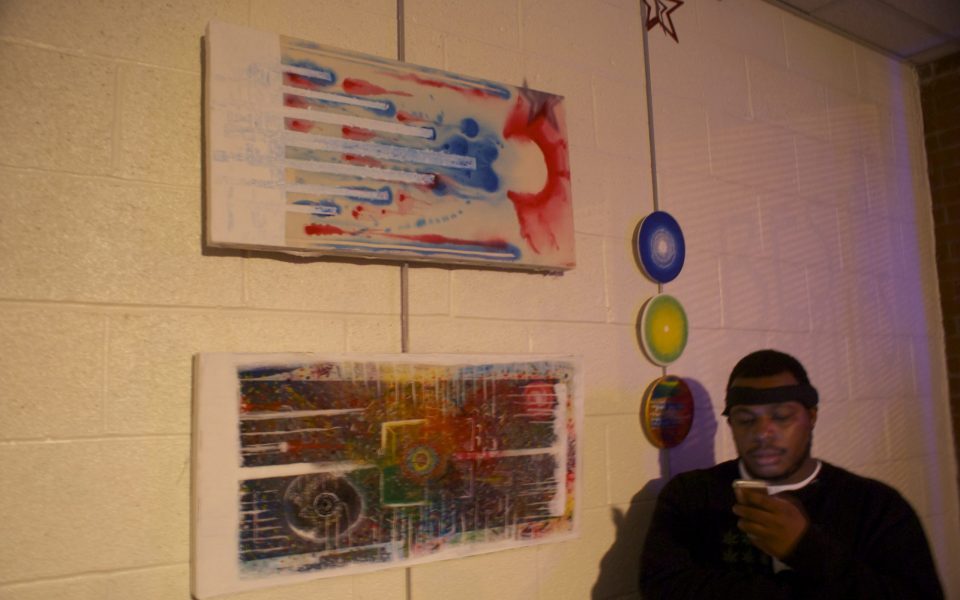by Anthony Harrison
The Artist Bloc’s slogan reads, “Where creative minds meet.” Despite the audacious mission statement, they hold court without presumption. The store sits squarely in the middle of Greensboro’s tiny West Lee Center strip, near Beef Burger.
While the location is modest, the work inside is inspiring. Visual artists of all disciplines come together to present original pieces, and the art along its whitewashed walls all thrills the eye.
On Feb. 27, the Artist Bloc held a reception for their latest staff exhibition, with a focus on store manager Jordan Robinson’s work.
Before the formal opening, a few dozen people milled around, enjoying complimentary hors d’oeuvres, drinking wine and chatting.
“Leonard Nimoy died,” one said. “Today’s been a rough day.”
“Are we done with the snow?” another asked. “I lived in Queens, and I thought I’d left the snow behind. But it just followed me down I-95.”
The idea of people meeting together, shooting the breeze and enjoying food and drink is not restricted to soirees at the Artist Bloc, but the space is at once a gallery, supply store, performance venue, teaching space and coffee bar.
Feb. 27 held importance, though.
Robinson, dressed in gray jacket, black shirt and white bowtie, announced the official beginning of the showcase, then opened the podium to the artists.
First was Jay Squid, whose art draws as much from African tribal influences [repetitive of subsequent quote] as it does from popular culture.
“I like to have a lot of tribal influences because I come from a large family,” Squid said. “I like the idea of being part of something bigger than myself.”
A tribal-mask motif often presents itself in her work. In “The Beauty in Her Sadness,” a piece seemingly inspired by anime with its perfectly strange proportions, Squid acknowledged she took bits and pieces of beauty she’d seen in people in her life and hid it slightly behind a mask of watercolor. The effect suggests makeup to hide melancholy.
On her pop-art mashup, “ADIDAStormTroopers,” Squid admitted, “I really was just playing around. I liked the idea of a Run-DMC Stormtrooper [from Star Wars].”
Anthony Patterson next mounted the stage. Patterson’s art straddles the line between abstraction and impressionism, which makes sense — he admitted Jackson Pollock as a major inspiration, but his father was also an impressionist painter who attended NC A&T University.
Two of Patterson’s abstract-expressionist works dominated his showing. Both were untitled, but a bright yellow dominated one, only set off by timid slashes of black and white.
“I was testing out how great this [yellow] paint was,” Patterson said, “and it came out great.”
Patterson called other abstract work “a conversation piece,” informed both by his love for canvas and graffiti. It involved more colors than his other abstract piece: bright greens, rusty browns and light blues moved the eye.
“What would be your dream spot to tag?” one attendee asked.
“I don’t really know,” Patterson answered. “But when you see it, you’ll know.”
Patterson’s tag is “AP,” but he did not divulge the exact composition.
Stephen McIntyre then presented two very different pieces: one photorealistic painting called “My Materials,” and another titled “UNITY.”
“[My materials] are very important to me, and I wanted to show that,” McIntyre said.
McIntyre mentioned he’d hidden his initials in among the paint tubes, pencils and other pieces.
“I still get phone calls saying, ‘I just found the A!’” McIntyre said.
“UNITY” took its inspiration from both color-field theory and McIntyre’s work with children; while the piece renders the image of children, alternating squares of cool colors set against warm ones spell out the title.
Jahlisa Misenheimer showed an untitled work of a tiger, half precise and half abstracted. While a realistic representation, the left half only shows a roaring tiger in ink lines, while Misenheimer colored the right half with spits of burnt-orange paint.
“I change my mind with everything,” Misenheimer said. “Throughout the day, week, month, whatever, I add different things.”
She continued, “All my work never looks how it started, because I’m always working.”
Finally, Robinson had the chance to discuss his own work.
Robinson, a recent A&T media-design graduate, will soon attend the Savannah College of Art and Design, and the exhibit party celebrated him and his triumphs.
While Robinson focused on design in school, he stated, “I paint personally and for myself.”
Two of his pieces could stand individually, but they remain companions: “Thought vs. Feeling.”
Robinson explained, when composing the pieces, that he decided color and its emotional power would battle one another, and form and its rational power would fight against the other.
“Thought vs. Feeling: Feeling” seems blank, dominated by dripping white and straight lines, but color fights for the eye with rosy reds and light blue. Conversely, deep greens and splashes of red flood “Thought vs. Feeling: Thought,” but light traces of geometric patterns still pop through the field.
To top off the night, local musicians and comedians performed for the ever-growing crowd. After all, the Artist Bloc wishes to be a performance space for all types of artists.
“Working together brings prosperity for a group of people,” Robinson said. “The Artist Bloc is for the creative community by creative people.”
Join the First Amendment Society, a membership that goes directly to funding TCB‘s newsroom.
We believe that reporting can save the world.
The TCB First Amendment Society recognizes the vital role of a free, unfettered press with a bundling of local experiences designed to build community, and unique engagements with our newsroom that will help you understand, and shape, local journalism’s critical role in uplifting the people in our cities.
All revenue goes directly into the newsroom as reporters’ salaries and freelance commissions.



Leave a Reply